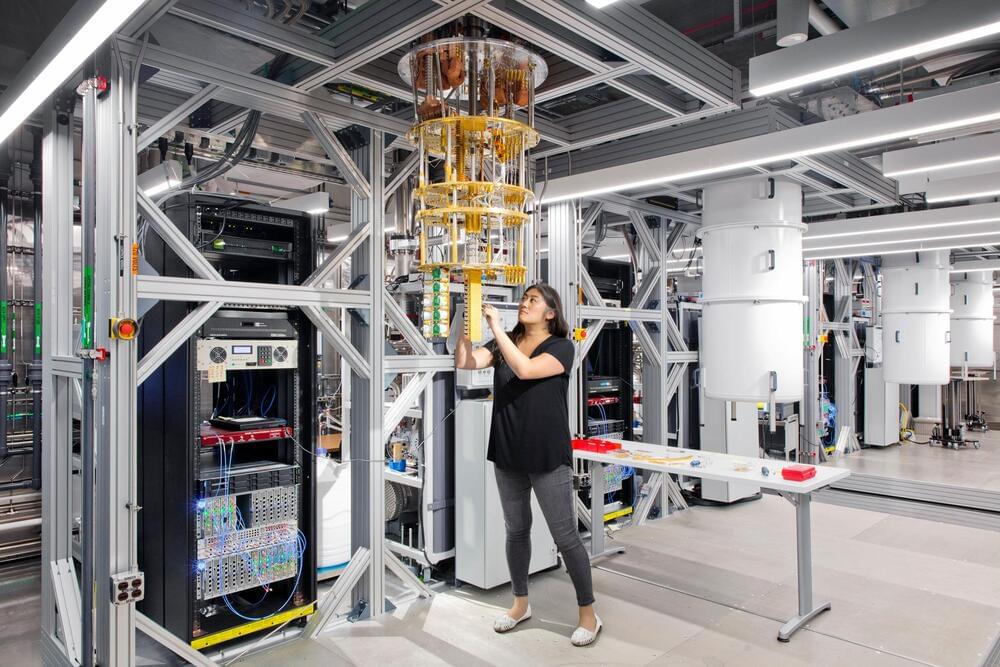By injecting algae into a tadpole’s head, scientists seem to have created a photosynthetic animal.
Today’s classical supercomputers can do a lot. But because their calculations are limited to binary states of 0 or 1, they can struggle with enormously complex problems such as natural science simulations. This is where quantum computers, which can represent information as 0, 1, or possibly both at the same time, might have an advantage.
Last year, IBM debuted a 127-qubit computing chip and a structure called the IBM Quantum System Two, intended to house components like the chandelier cryostat, wiring, and electronics for these bigger chips down the line. These developments edged IBM ahead of other big tech companies like Google and Microsoft in the race to build the most powerful quantum computer. Today, the company is laying out its three-year-plan to reach beyond 4,000-qubits by 2025 with a processor it is calling “Kookaburra.” Here’s how it is planning to get there.”
To get to its 2025 goal of a 4,000 qubit plus chip, IBM has micro-milestones it wants to hit on both the hardware and software side.
A long-standing quest for science and technology has been to develop electronics and information processing that operate near the fastest timescales allowed by the laws of nature.
A promising way to achieve this goal involves using laser light to guide the motion of electrons in matter, and then using this control to develop electronic circuit elements—a concept known as lightwave electronics.
Remarkably, lasers currently allow us to generate bursts of electricity on femtosecond timescales—that is, in a millionth of a billionth of a second. Yet our ability to process information in these ultrafast timescales has remained elusive.
CRISPR-Cas9 is considered a revolutionary gene editing tool, but its applications are limited by a lack of methods by which it can be safely and efficiently delivered into cells. Recently, a research team from Kumamoto University, Japan, have constructed a highly flexible CRISPR-Cas9 carrier using aminated polyrotaxane (PRX) that can not only bind with the unusual structure of Cas9 and carry it into cells, but can also protect it from intracellular degradation by endosomes.
Clustered regularly interspaced short palindromic repeats (CRISPR) and their accompanying protein, CRISPR-associated protein 9 (Cas9), made international headlines a few years ago as a game-changing genome editing system. Consisting of Cas9 and strand of genetic material known as a single-guide RNA (sgRNA), the system can target specific regions of DNA and function as “molecular scissors” to make precise edits. The direct delivery of Cas9–sgRNA complexes, i.e. Cas9 ribonucleoproteins (RNPs), into the nucleus of the cell is considered the safest and most efficient way to achieve genome editing. However, the Cas9 RNP has poor cellular permeability, and thus requires a carrier molecule to transport it past the first hurdle of the cell membrane before it can get to the cell nucleus. These carriers need to bind with Cas9 RNP, carry it into the cell, prevent its degradation by intracellular organelles called “endosomes,” and finally release it without causing any changes to its structure.
In a recent paper published in the June 2022, Volume 27 of Applied Materials Today, a research team from Kumamoto University has developed a transformable polyrotaxane (PRX) carrier that can facilitate genome editing using Cas9RNP with high efficiency and usability. “While there have been some PRX-based drug carriers for nucleic acids and proteins reported before, this is the first report on PRX-based Cas9 RNP carrier. Moreover, our findings describe how to precisely control intracellular dynamics across multiple steps. This will prove invaluable for future research in this direction,” says Professor Keiichi Motoyama, a corresponding author of the paper.
A group of researchers from Pisa, Jyväskylä, San Sebastian and MIT have demonstrated how a heterostructure consisting of superconductors and magnets can be used to create unidirectional current like that found in semiconductor diodes.
These novel superconductor diodes, however, operate at much lower temperatures than their semiconductor counterparts and are therefore useful in quantum technologies.
EPFL scientists have developed a digital model of the fruit fly, Drosophila melanogaster, that realistically simulates the movements of the animal. The twin is a big step towards reverse engineering the neuromechanical control of animal behavior, and developing bioinspired robots.
“We used two kinds of data to build NeuroMechFly,” says Professor Pavan Ramdya at EPFL’s School of Life Sciences. “First, we took a real fly and performed a CT scan to build a morphologically realistic biomechanical model. The second source of data were the real limb movements of the fly, obtained using pose estimation software that we’ve developed in the last couple of years that allow us to precisely track the movements of the animal.”
Ramdya’s group, working with the group of Professor Auke Ijspeert at EPFL’s Biorobotics Laboratory, has published a paper in Nature Methods showcasing the first ever accurate “digital twin” of the fly Drosophila melanogaster, dubbed “NeuroMechFly”.
Modern computers use electrons to process information, but this design is starting to reach theoretical limits. However, it could be possible to use magnetism instead and thereby keep up the development of both cheaper and more powerful computers, thanks to work by scientists from the Niels Bohr Institute (NBI) and University of Copenhagen. Their study is published in the journal Nature Communications.
“The function of a computer involves sending electric current through a microchip. While the amount is tiny, the current will not only transport information but also contribute to heating up the chip. When you have a huge number of components tightly packed, the heat becomes a problem. This is one of the reasons why we have reached the limit for how much you can shrink the components. A computer based on magnetism would avoid the problem of overheating,” says Professor Kim Lefmann, Condensed Matter Physics, NBI.
“Our discovery is not a direct recipe for making a computer based on magnetism. Rather we have disclosed a fundamental magnetic property which you need to control, if you want to design a such computer.”
A revolutionary new DNA detection method has helped rediscover an iconic species of turtle last seen more than 25 years ago in a northern Queensland river.
Water samples taken from the lower Burdekin River by a James Cook University-led team of researchers and analyzed for environmental DNA (eDNA) confirmed the presence of the Irwin’s turtle at many sites along the river, which has not been formally recorded in the area for more than 25 years.
The turtle, first discovered in the Burdekin catchment by the late Steve Irwin and his father Bob in the early 1990s, is among a number of freshwater species that uses its cloaca (equivalent to its bum) to breathe while underwater, which allows it to stay submerged underwater for longer.
A window to life in the deep subsurface, which may resolve the mystery of methane on Mars.
SpaceX COO and President Gwynne Shotwell says that the company now expects Starbase to be ready for Starship’s first orbital launch attempt as early as June or July, pushing the schedule back another month or two.
To accomplish that feat, SpaceX will need to more or less ace a wide range of challenging and unproven tests and pass a series of exhaustive bureaucratic reviews, significantly increasing the odds that Starship’s orbital launch debut is actually closer to 3–6 months away. While SpaceX could technically pull off a miracle or even attempt to launch hardware that has only been partially tested, even the most optimistic of hypothetical scenarios are still contingent upon things largely outside of the company’s control.
Both revolve around the Federal Aviation Administration (FAA), which – in SpaceX’s case – is responsible for completing a ‘programmatic environmental assessment’ (PEA) of orbital Starship launches out of Boca Chica, Texas and issuing a launch license for the largest and most powerful rocket ever built. In some ways, both tasks are unprecedented, but the bureaucratic processes involved are still largely the same as those SpaceX has successfully navigated over the last two decades.









